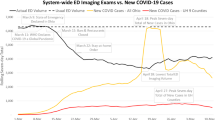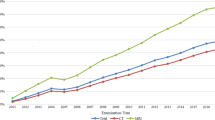Abstract
Purpose
To identify and characterize the most frequent users of emergency department (ED) imaging.
Materials and methods
All patients with at least one ED visit in 2016 across a four-hospital healthcare system were retrospectively identified and their ED imaging utilization characterized.
Results
Overall, 126,940 unique patients underwent 187,603 ED visits (mean 1.5 ± 1.7) and a total of 192,142 imaging examinations (mean 1.7 ± 2.7). Fifty-eight percent of patients were imaged (73,672) and underwent a mean 2.6 ± 2.7 exams. When ranked by ED visits, 1.6% (2007) of patients had ≥ 4 ED visits (mean 6.1 ± 5.4). These ED “clinical superusers” accounted for 7.7% (14,409) of total ED visits and underwent 6.8 ± 5.4 imaging examinations, while non-superusers underwent 1.5 ± 2.2 (p < 0.01). When ranked by ED imaging utilization, 12.3% (15,575) of patients underwent ≥ 4 ED imaging examinations and consumed 49.5% (95,053) of all imaging services. A subset of just 1.3% (1608) of ED patients underwent > 10 annual ED examinations (ED “imaging superusers”) and accounted for 12.4% (23,787) of all ED imaging services. Only 0.4% (n = 472) of patients were both clinical and imaging superusers. Despite similar ED visits to clinical superusers (6.0 ± 5.6 vs. 6.1 ± 5.4, p = 0.92), imaging superusers underwent significantly more imaging (14.8 ± 4.8 vs. 6.8 ± 5.4 examinations, p < 0.01).
Conclusion
Just 12% of ED patients consume 50% of all ED imaging services, and 1.3% consume 12.4%. These ED imaging superusers represent a distinct group from clinical superusers. Prospective identification of this newly described subgroup might permit targeted interventions to control ED imaging volume, restrain costs, and minimize per-patient radiation exposure.





Similar content being viewed by others
References
Pitts SR, Pines JM, Handrigan MT, Kellermann AL (2012) National trends in emergency department occupancy, 2001 to 2008: effect of inpatient admissions versus emergency department practice intensity. Ann Emerg Med 60(6):679–86.e3. https://doi.org/10.1016/j.annemergmed.2012.05.014
Rosenkrantz AB, Bonavita JA, Foran MP, Matza BW, McMenamy JM (2014) Is there an association between radiologist turnaround time of emergency department abdominal CT studies and radiologic report quality? Emerg Radiol 21(1):5–10. https://doi.org/10.1007/s10140-013-1164-2
Herring A, Wilper A, Himmelstein DU, Woolhandler S, Espinola JA, Brown DF et al (2009) Increasing length of stay among adult visits to U.S. emergency departments, 2001-2005. Acad Emerg Med Off J Soc Acad Emerg Med 16(7):609–616. https://doi.org/10.1111/j.1553-2712.2009.00428.x
Hsia RY, Kellermann AL, Shen YC (2011) Factors associated with closures of emergency departments in the United States. JAMA 305(19):1978–1985. https://doi.org/10.1001/jama.2011.620
Niska R, Bhuiya F, Xu J (2010) National hospital ambulatory medical care survey: 2007 emergency department summary. Natl Health Stat Report (26):1–31.
Tang N, Stein J, Hsia RY, Maselli JH, Gonzales R (2010) Trends and characteristics of US emergency department visits, 1997-2007. Jama 304(6):664–670. https://doi.org/10.1001/jama.2010.1112
Vegting IL, Nanayakkara PW, van Dongen AE, Vandewalle E, van Galen J, Kramer MH, Bonjer J, Koole GM, Visser MC (2011) Analysing completion times in an academic emergency department: coordination of care is the weakest link. Neth J Med 69(9):392–398
LaCalle E, Rabin E (2010) Frequent users of emergency departments: the myths, the data, and the policy implications. Ann Emerg Med 56(1):42–48. https://doi.org/10.1016/j.annemergmed.2010.01.032
Blank FS, Li H, Henneman PL, Smithline HA, Santoro JS, Provost D et al (2005) A descriptive study of heavy emergency department users at an academic emergency department reveals heavy ED users have better access to care than average users. J Emerg Nurs 31(2):139–144. https://doi.org/10.1016/j.jen.2005.02.008
Fuda KK, Immekus R (2006) Frequent users of Massachusetts emergency departments: a statewide analysis. Ann Emerg Med 48(1):9–16. https://doi.org/10.1016/j.annemergmed.2006.03.001
Ruger JP, Richter CJ, Spitznagel EL, Lewis LM (2004) Analysis of costs, length of stay, and utilization of emergency department services by frequent users: implications for health policy. Acad Emerg Med Off J Soc Acad Emerg Med 11(12):1311–1317. https://doi.org/10.1197/j.aem.2004.07.008
Kne T, Young R, Spillane L (1998) Frequent ED users: patterns of use over time. Am J Emerg Med 16(7):648–652
Locker TE, Baston S, Mason SM, Nicholl J (2007) Defining frequent use of an urban emergency department. Emerg Med J 24(6):398–401. https://doi.org/10.1136/emj.2006.043844
Byrne M, Murphy AW, Plunkett PK, McGee HM, Murray A, Bury G (2003) Frequent attenders to an emergency department: a study of primary health care use, medical profile, and psychosocial characteristics. Ann Emerg Med 41(3):309–318. https://doi.org/10.1067/mem.2003.68
Doupe MB, Palatnick W, Day S, Chateau D, Soodeen RA, Burchill C, Derksen S (2012) Frequent users of emergency departments: developing standard definitions and defining prominent risk factors. Ann Emerg Med 60(1):24–32. https://doi.org/10.1016/j.annemergmed.2011.11.036
Hunt KA, Weber EJ, Showstack JA, Colby DC, Callaham ML (2006) Characteristics of frequent users of emergency departments. Ann Emerg Med 48(1):1–8. https://doi.org/10.1016/j.annemergmed.2005.12.030
Mandelberg JH, Kuhn RE, Kohn MA (2000) Epidemiologic analysis of an urban, public emergency department’s frequent users. Acad Emerg Med Off J Soc Acad Emerg Med 7(6):637–646
Althaus F, Paroz S, Hugli O, Ghali WA, Daeppen JB, Peytremann-Bridevaux I, Bodenmann P (2011) Effectiveness of interventions targeting frequent users of emergency departments: a systematic review. Ann Emerg Med 58(1):41–52 e42. https://doi.org/10.1016/j.annemergmed.2011.03.007
Vinton DT, Capp R, Rooks SP, Abbott JT, Ginde AA (2014) Frequent users of US emergency departments: characteristics and opportunities for intervention. Emerg Med J 31(7):526–532. https://doi.org/10.1136/emermed-2013-202407
Krieg C, Hudon C, Chouinard MC, Dufour I (2016) Individual predictors of frequent emergency department use: a scoping review. BMC Health Serv Res 16(1):594. https://doi.org/10.1186/s12913-016-1852-1
Milani SA, Crooke H, Cottler LB, Striley CW (2016) Sex differences in frequent ED use among those with multimorbid chronic diseases. Am J Emerg Med 34(11):2127–2131. https://doi.org/10.1016/j.ajem.2016.07.059
Levin DC, Rao VM, Parker L, Frangos AJ (2014) Continued growth in emergency department imaging is bucking the overall trends. J Am Coll Radiol 11(11):1044–1047. https://doi.org/10.1016/j.jacr.2014.07.008
Prabhakar AM, Gottumukkala RV, Hemingway J, Hughes DR, Patel SS, Duszak R Jr (2017) Increasing utilization of emergency department neuroimaging in Medicare beneficiaries from 1994 to 2015. Am J Emerg Med. https://doi.org/10.1016/j.ajem.2017.12.057
Ditkofsky N, Shekhani HN, Cloutier M, Chen ZN, Zhang C, Hanna TN (2016) Ionizing radiation knowledge among emergency department providers. J Am Coll Radiol 13(9):1044–1049 e1. https://doi.org/10.1016/j.jacr.2016.03.011
Wasser EJ, Prevedello LM, Sodickson A, Mar W, Khorasani R (2013) Impact of a real-time computerized duplicate alert system on the utilization of computed tomography. JAMA Intern Med 173(11):1024–1026. https://doi.org/10.1001/jamainternmed.2013.543
Shivade C, Raghavan P, Fosler-Lussier E, Embi PJ, Elhadad N, Johnson SB et al (2014) A review of approaches to identifying patient phenotype cohorts using electronic health records. J Am Med Inform Assoc 21(2):221–230. https://doi.org/10.1136/amiajnl-2013-001935
IRB statement
This study was reviewed and approved by our institutional IRB.
Author information
Authors and Affiliations
Corresponding author
Ethics declarations
Conflict of interest
The authors declare that they have no conflict of interest.
Disclosures
MH and RD receive research support from the Harvey L. Neiman Health Policy Institute (Reston, VA). TNH is a 2017–2018 recipient of the American Society of Emergency Radiology Educational Grant.
Rights and permissions
About this article
Cite this article
Hanna, T.N., Kundu, S., Singh, K. et al. Emergency department imaging superusers. Emerg Radiol 26, 161–168 (2019). https://doi.org/10.1007/s10140-018-1659-y
Received:
Accepted:
Published:
Issue Date:
DOI: https://doi.org/10.1007/s10140-018-1659-y




